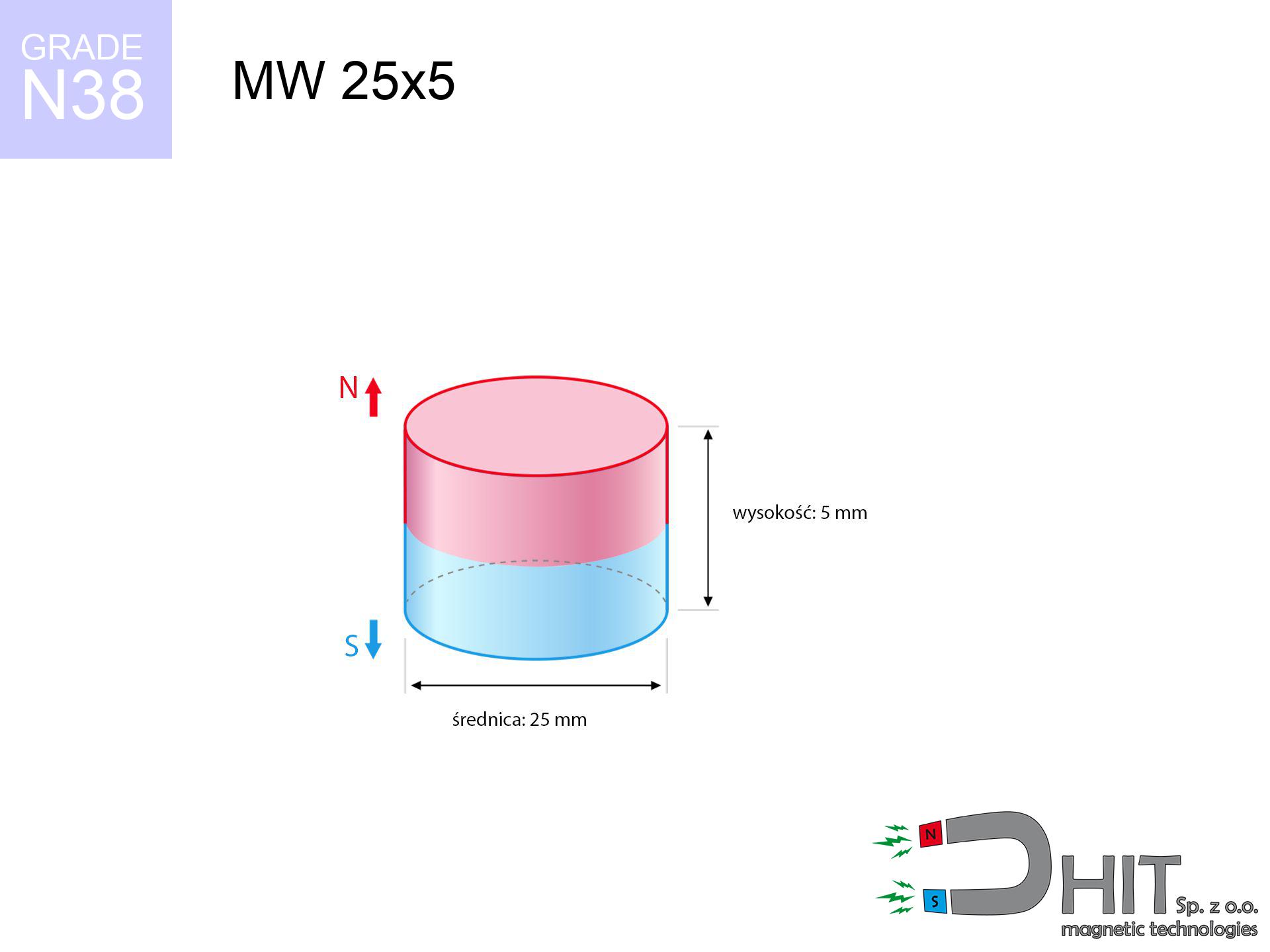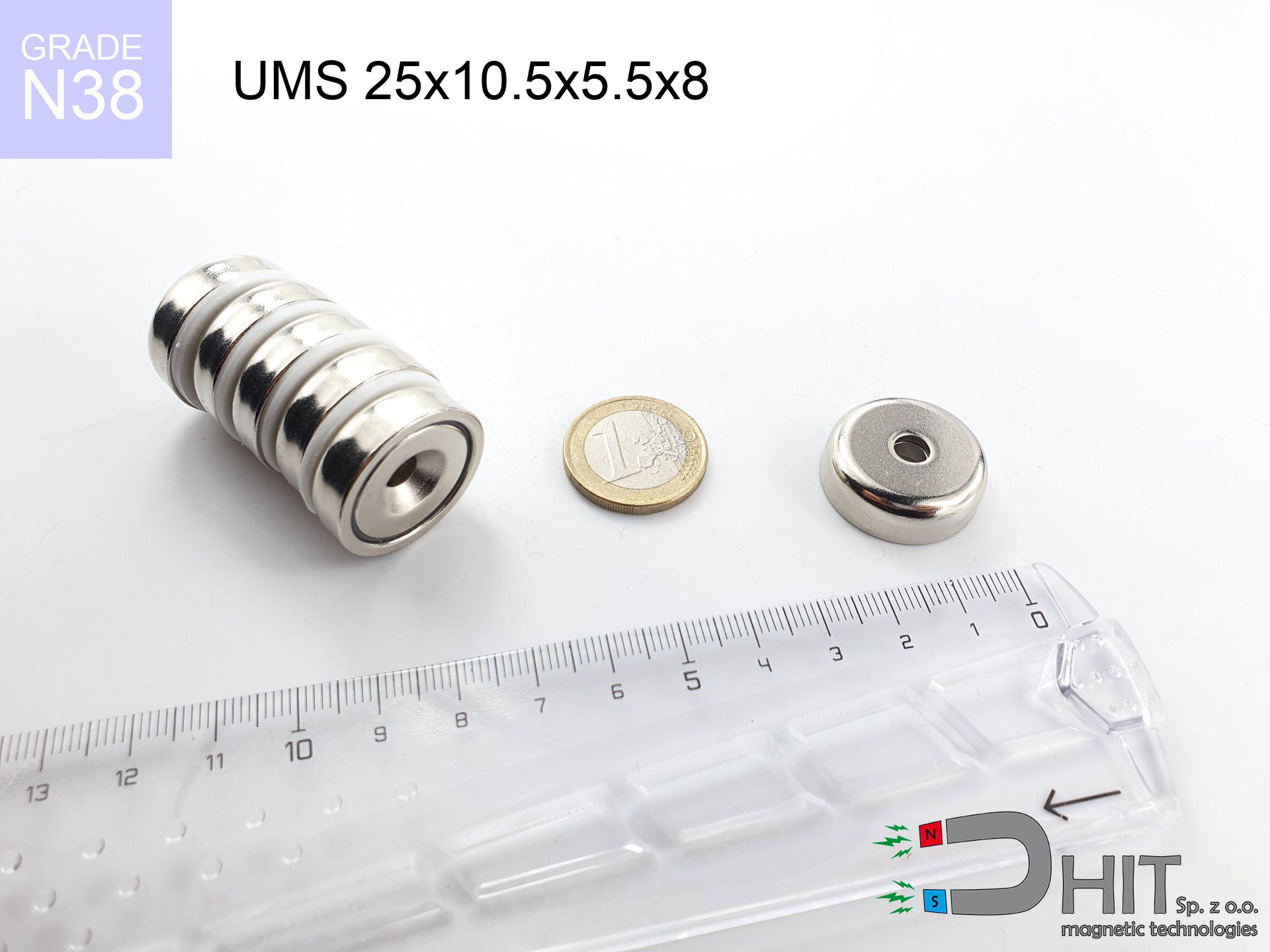MW 25x5 / N38 - cylindrical magnet
cylindrical magnet
Catalog no 010049
GTIN: 5906301810483
Diameter Ø [±0,1 mm]
25 mm
Height [±0,1 mm]
5 mm
Weight
18.41 g
Magnetization Direction
↑ axial
Load capacity
6.91 kg / 67.76 N
Magnetic Induction
230.20 mT
Coating
[NiCuNi] nickel
7.48 ZŁ net + 23% VAT / pcs
Want to negotiate the price?
Call us +48 22 499 98 98 or write via form on the contact page. Test the magnet's power with our power calculator.
Orders placed by 14:00 are shipped the same day.
MW 25x5 / N38 - cylindrical magnet
Magnetic properties of material N38
Physical properties of NdFeB
Shopping tips
Moreover, although neodymium is part of the strongest magnets, they are susceptible to corrosion in humid environments. For this reason, they are coated with a thin layer of nickel to increase their durability. Interestingly that NdFeB neodymium magnets are about 13% lighter than SmCo magnets and, despite their power, are brittle, which requires special caution during their handling. For this reason, any mechanical processing should be done before they are magnetized.
In terms of safety, there are many recommendations regarding the use of these magnets. It is advisable to avoid their use in acidic, basic, organic environments or in solvents, as well as in water or oil. Additionally, they can distort data on magnetic cards and hard drives, although data deletion using a neodymium magnet is not always certain.
In terms of properties in different environments, neodymium magnets are sensitive to corrosion, especially in conditions of high humidity. Therefore, they are often coated with coatings, such as epoxy, to shield them from environmental factors and extend their lifespan. Temperatures exceeding 130°C can result in a reduction of their magnetic strength, although there are specific types of neodymium magnets that can tolerate temperatures up to 230°C.
As for potential dangers, it is important to avoid using neodymium magnets in acidic environments, basic conditions, organic or solvent environments, unless they are properly protected. Additionally, their use is not recommended in wet conditions, oil, or in an atmosphere containing hydrogen, as they may forfeit their magnetic strength.
Advantages and disadvantages of neodymium magnets
Neodymium magnets, also known as NdFeB magnets, are currently the strongest permanent magnets available on the market. Their exceptional magnetic properties make them suitable for various industries, technologies, and everyday life. Below are the key advantages:
- Immense attractive force: Even small neodymium magnets generate a very strong magnetic field.
- High coercivity: They are resistant to demagnetization by external magnetic fields.
- Wide operating temperature range: Standard neodymium magnets operate up to 80°C, with special versions up to 230°C.
- Variety of shapes and sizes: Available in many forms, making them easy to adapt to specific applications.
- Relatively low price compared to strength: They offer the best strength-to-price ratio among all magnets.
- Longevity: With proper use, they retain their magnetic properties for many years.
- Versatility of applications: From electric motors to speakers, separators, toys, and jewelry.
Despite numerous advantages, neodymium magnets also have certain disadvantages to consider:
- Brittleness: They are hard but brittle and prone to cracking or chipping upon impact.
- Limited operating temperature for standard versions: Above the Curie temperature, they lose their magnetic properties.
- Strong magnetic field can be dangerous: They can damage electronics, magnetic cards, and pose a risk of attracting metal objects with great force.
- Difficulties in mechanical processing: Due to their hardness and brittleness, processing them is complex.
Precautions with Neodymium Magnets
Neodymium Magnets can attract to each other due to their immense internal force, causing the skin and other body parts to get pinched and resulting in significant injuries.
In the case of holding a finger in the path of a neodymium magnet, in that situation, a cut or even a fracture may occur.
Do not give neodymium magnets to youngest children.
Neodymium magnets are not toys. You cannot allow them to become toys for children. In such a situation, surgery is necessary to remove them. In the worst case scenario, it can result in death.
Keep neodymium magnets away from people with pacemakers.
In the case of neodymium magnets, there is a strong magnetic field. As a result, it interferes with the operation of a heart pacemaker. However, if the magnetic field does not affect the device, it can damage its components or deactivate the device when it is in a magnetic field.
Dust and powder from neodymium magnets are highly flammable.
Do not attempt to drill into neodymium magnets. Mechanical processing is also not recommended. Once crushed into fine powder or dust, this material becomes highly flammable.
Neodymium magnetic are characterized by being fragile, which can cause them to shatter.
Neodymium magnets are characterized by considerable fragility. Neodymium magnets are made of metal and coated with a shiny nickel surface, but they are not as hard as steel. In the event of a collision between two magnets, there may be a scattering of fragments in different directions. Protecting your eyes is crucial in such a situation.
Neodymium magnets are over 10 times more powerful than ferrite magnets (the ones in speakers), and their power can surprise you.
To handle magnets properly, it is best to familiarize yourself with our information beforehand. This will help you avoid significant harm to your body and the magnets themselves.
Neodymium magnets can become demagnetized at high temperatures.
While Neodymium magnets can demagnetize at high temperatures, it's important to note that the extent of this effect can vary based on factors such as the magnet's material, shape, and intended application.
Never bring neodymium magnets close to a phone and GPS.
Neodymium magnets generate strong magnetic fields that interfere with magnetometers and compasses used in navigation, as well as internal compasses of smartphones and GPS devices.
Avoid contact with neodymium magnets if you have a nickel allergy.
Studies show a small percentage of people have allergies to certain metals, including nickel. An allergic reaction often manifests as skin redness and rash. If you have a nickel allergy, try wearing gloves or avoid direct contact with nickel-plated neodymium magnets.
Make sure not to bring neodymium magnets close to the TV, wallet, and computer HDD.
Strong fields generated by neodymium magnets can damage magnetic storage media such as floppy disks, credit cards, magnetic ID cards, cassette tapes, video tapes, or other similar devices. In addition, they can damage televisions, VCRs, computer monitors, and CRT displays. You should especially avoid placing neodymium magnets near electronic devices.
To show why neodymium magnets are so dangerous, read the article - How very dangerous are very powerful neodymium magnets?.





![BM 450x180x70 [4x M8] - magnetic beam BM 450x180x70 [4x M8] - magnetic beam](https://cdn3.dhit.pl/graphics/products/bm-450x180x70-4x-m8-duh.jpg)
![SM 32x400 [2xM8] / N52 - magnetic separator SM 32x400 [2xM8] / N52 - magnetic separator](https://cdn3.dhit.pl/graphics/products/sm-32x400-2xm8-led.jpg)


